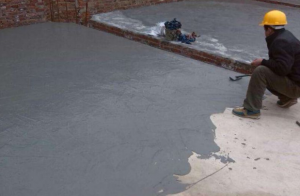Polymer cement waterproof coating construction points and precautions!
date: 2020-03-20 18:27:51Source: RG JIAYEViews: 4727
Polymer cement waterproof coating, also known as JS waterproof coating, is an organic liquid material composed of polymer emulsion such as polyacrylate emulsion, ethylene-vinyl acetate copolymer emulsion and various additives, and cement, quartz sand, light and heavy calcium carbonate. A kind of two-component, water-based building waterproof coating made of inorganic powder composed of other inorganic fillers and various additives through reasonable mixing and compounding.

Product features of polymer cement waterproof coating:
1. Non-toxic, harmless, pollution-free, safe to use, without any harm to the surrounding environment and personnel.
2. Can be directly applied on wet (no water) or dry substrates.
3. The coating is tough and high-strength, with excellent water resistance, weather resistance, and durability, and can withstand high temperatures of 140 ° C. It is particularly suitable for road and bridge waterproofing, and can be pigmented to form a color coating.
4. Can be directly applied on the elevation, slope and top surface without flowing. Simple construction, easy operation, short construction period, the coating can be self-dried under normal temperature conditions, which is convenient for maintenance.
5.It can be firmly bonded to various base materials such as the base surface and cement mortar. It is an ideal repairing bonding material. It has good adhesion to a variety of building materials and can form an overall seamless, dense and stable elastic waterproof layer. .
Application range of polymer cement waterproof coating:
1. Polymer cement waterproof coating is most suitable for waterproof, impervious and moisture-proof projects of non-exposed roofs, toilets and external walls.
2. It can also be used for waterproofing of coating films in underground works and tunnels and caves.
3. Road, bridge, pool, water conservancy engineering coating waterproofing project.
What should I pay attention to when applying polymer cement waterproof coating?
1. uneven stirring
The performance of JS waterproof coating has a direct relationship with the degree of uniform mixing of liquid and powder. Although the manufacturer’s instructions and packaging stipulate the correct method of on-site mixing, in the actual operation process, many construction teams perfunctory the mixing process, and even find a few sticks on the scene to manually stir the mixture to make it solidify. After the film performance is greatly reduced.
2. Too much water
In order to improve the permeability of the coating to the base layer and the adhesion to the base layer, most manufacturers will recommend in the instructions for use that the coating can be diluted by adding more water than the specified amount of water during the first brush application. Therefore, many people have misunderstood that JS waterproof coating can be added with water at will, and it is this operation that destroys the proportion of the formula of the waterproof coating. The formula of the product is optimized after several experiments to balance the mechanical properties and construction of the material Performance, arbitrarily changing the proportion of any of these components has a great impact on the performance of the coating film.
3. Unclear acceptance criteria
What indicators can restrict the construction workers to standardize the construction and make the waterproof layer achieve the expected effect? Number of construction passes? Dosage per unit area? Imagine diluting the waterproof coating with water several times and painting to the number of passes required for construction; the base layer is uneven, and the amount of unit area is guaranteed during construction. Although the above conditions all meet the requirements, but due to different actual conditions, the waterproof effect and durability can not reach the expected effect. Some studies have pointed out that the impermeability of JS waterproof coating obviously depends on the change of material thickness, and a sudden change occurs within a certain thickness range; as the thickness of the specimen increases, the tensile strength decreases and the elongation increases. Therefore, taking the average thickness of the waterproof layer as the basis for acceptance of the waterproofing project can not only avoid the influence of objective conditions, but also ensure the mechanical properties and waterproof effect of the waterproof layer.
If the waterproof layer is too thin, it will reduce the overall waterproof effect and shorten the durability of the waterproof layer; if it is too thick, it will cause waste in a certain sense. The basic thickness of JS waterproof coating is 1.5 ~ 2.0mm, and part of the design and construction monitoring often only pay attention to the number of construction passes but ignore the final thickness of the coating. Therefore, in addition to indicating “several cloths and several coats” and the amount of unit area in the waterproof design and construction process, the thickness requirements of the coating film should also be marked, and the average thickness is used as the acceptance basis for the waterproof project.
4. No key parts of the carcass
Details of joints such as yin and yang corners, pipeline roots, etc. are prone to cracking due to stress concentration. Usually, the reinforcement of the carcass can avoid the above situation. The setting of the enhanced carcass position directly affects the use effect. It should be that the closer the carcass is to the base layer, the more the effect of dispersing stress can be achieved. In fact, in many projects, the carcass position is set at will without any care. .
Polymer cement waterproof coating construction tips:
1. The overlap seams parallel to the ridge of the roof shall overlap in the direction of flowing water.
2. The overlapping seams of vertical ridges should overlap with the wind direction of the maximum frequency in the year.
3. For each layer of APF waterproof coating that is laminated, the polymer cement waterproof coating should be overlapped at the junction between the gutter and the roof, and the joints should be staggered.
4. The overlap seam should be left at the back or the side of the gutter. It should not be left at the bottom of the trench. Waterproof coating construction process.








